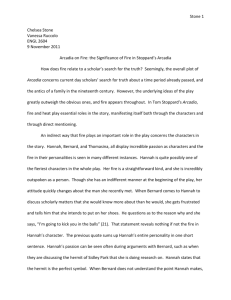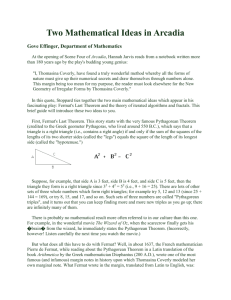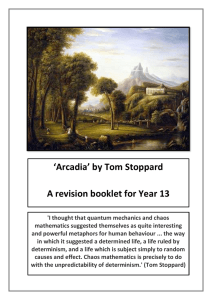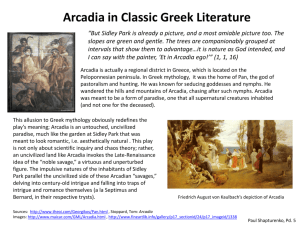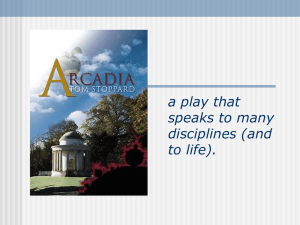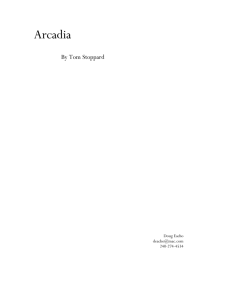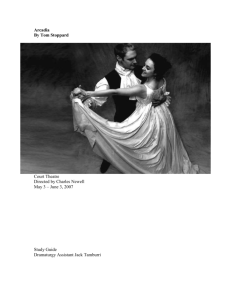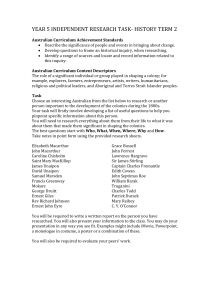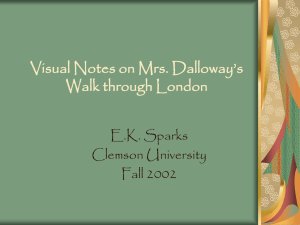What Time Travel Brings to Science Plays
advertisement
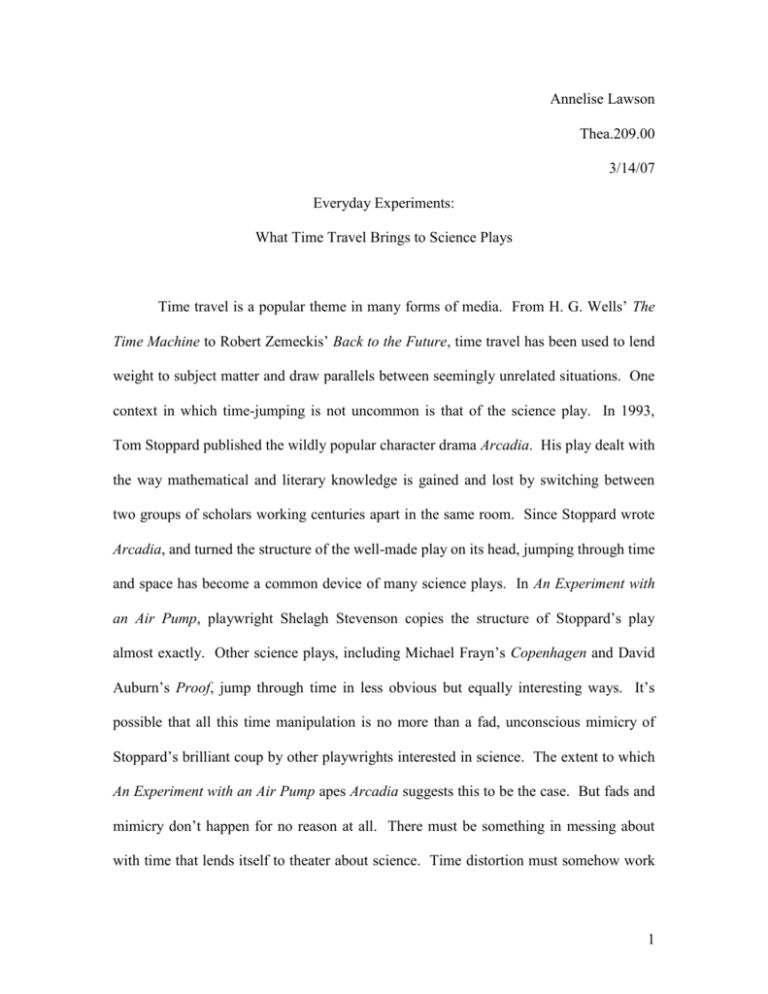
Annelise Lawson Thea.209.00 3/14/07 Everyday Experiments: What Time Travel Brings to Science Plays Time travel is a popular theme in many forms of media. From H. G. Wells’ The Time Machine to Robert Zemeckis’ Back to the Future, time travel has been used to lend weight to subject matter and draw parallels between seemingly unrelated situations. One context in which time-jumping is not uncommon is that of the science play. In 1993, Tom Stoppard published the wildly popular character drama Arcadia. His play dealt with the way mathematical and literary knowledge is gained and lost by switching between two groups of scholars working centuries apart in the same room. Since Stoppard wrote Arcadia, and turned the structure of the well-made play on its head, jumping through time and space has become a common device of many science plays. In An Experiment with an Air Pump, playwright Shelagh Stevenson copies the structure of Stoppard’s play almost exactly. Other science plays, including Michael Frayn’s Copenhagen and David Auburn’s Proof, jump through time in less obvious but equally interesting ways. It’s possible that all this time manipulation is no more than a fad, unconscious mimicry of Stoppard’s brilliant coup by other playwrights interested in science. The extent to which An Experiment with an Air Pump apes Arcadia suggests this to be the case. But fads and mimicry don’t happen for no reason at all. There must be something in messing about with time that lends itself to theater about science. Time distortion must somehow work 1 to achieve dramatic effects important to the rhetorical objectives of playwrights exploring science. It seems that we may have stumbled upon a research question: what does all this time travel add to the genre of the science play? The obvious explanation is that it is no more than a dramaturgic device that enables the playwright to illustrate the process of scientific discovery for the audience. Scientific principles are observable only in concrete data. By jumping through time, a playwright can pack as much evidence as possible into a single play. However, a closer examination of how time is used in the science plays mentioned above (Arcadia in particular), as compared with its use in plays without a scientific focus, shows that jumping through time in the name of science is more than just a dramatic gimmick. Allow me to venture a hypothesis: jumping through time in science plays is a way of incorporating the scientific subject matter of a play into its larger structure in a way that allows the audience to discover the full extent to which heady scientific principles govern real life. In Tom Stoppard’s Arcadia, the audience is shown the same house hundreds of years apart. In the house of the past, we are introduced to the trials and tribulations of the Coverly household as they cope with the end of the Enlightenment and the onslaught of Romanticism. We grow particularly familiar with the relationship between Septimus, the sardonic tutor of the precocious Thomasina Coverly, as he tries to reconcile his beloved Newtonian Universe with the principles of Chaos Theory and the Second Law of Thermodynamics that his young ward discovers. In the house of the future, we see a group of scholars (two literary scholars and one chaotician), sorting through the sparse vestiges of its past, and trying arrive at a coherent picture of its history. The play 2 switches back and forth between the two times, showing us the true events of the past as we see the futuristic investigators struggle (often in vain) to find them. On the first reading, it seems as through Stoppard is using these parallel stories to make the point that we constantly manipulate and misuse the past; that it is impossible ever to fully understand what has happened, because people keep projecting their own needs onto history. One almost begins to wonder if the math is really essential to the structure of the play. After all, we would still have a wonderful human drama without all the talk of Chaos Theory and the Second Law of Thermodynamics. And if this interpretation is wrong, if the math really is the thing, then why would we need to jump around in time so much? Wouldn’t it be easier to elucidate the process of discovery by progressing chronologically through time? However, as soon as one tries to imagine Arcadia without the science, one realizes that the science is what gives the play’s discussion of knowledge its significance. In Arcadia, math is not just a field of study arbitrarily chosen to illustrate how intellectualism is inextricable from the more sentimental side of life. Stoppard uses the manipulation of time to show that his scientific subject matter actually governs the way life and personal relations work. Stoppard uses parallels in time to illustrate fundamental truths about the way that humans operate, specifically in the context of scholarly pursuits. In the world of the play, scholars are constantly trying to discover the real truths of life. The play suggests that no matter how hard we strive to understand everything, we still come up against the fact that knowledge is lost and warped with the passage of time. We are told by the future scholars that “real data is messy,” (p. 46) Humans don’t progress linearly in our pursuit of knowledge. Knowledge isn’t collective but is instead something that humans must toil 3 to assemble from the remnants of past discoveries. Bernard, a Don trying to discover whether or not Lord Byron shot a man in a duel at the house, says that all written evidence, “dropped from sight but we will write it again!” (p. 50) Math, it seems, is only one field in which such losses occur. Thomasina makes a discovery, it is lost because she is killed in the house fire, and doesn’t resurface again in the same way. However, it’s interesting that even as we are presented with this dismal picture of how knowledge is lost, we are consoled by Septimus’s statement that everything we do lose will be regained. In the course of their Latin lesson, Thomasina laments the loss of the contents of the library of Alexandria, crying, “How can we sleep for grief?” (p. 38) Septimus encourages her, saying, “We shed as we pick up, like travelers who must carry everything in their arms, and what we let fall will be picked up by those behind.” (p. 38). According to Septimus, nothing exists outside of the march of life and so nothing can ever be truly lost. Although humans collectively do lose precious information, we will eventually come around to it again. Septimus’s point seems to fall to pieces under the blow that is Thomasina’s discovery of the Second Law of Thermodynamics – that entropy is increasing and things are constantly being irrevocably lost – until Valentine, the present-day hero of Chaos Theory, backs him up. In explaining Thomasina’s iterated algorithm, he says that the chaos of noise and math can occasionally make a coherent picture, that a tune can eventually emerge from the broken piano playing that is raw data if we follow through on some good guesses. “In an ocean of ashes, islands of order.” (p. 76) Something can be made of nothing, he says. The world is “still doomed. But if this is how it started, perhaps it’s how the next one will come.” (p. 78). 4 The play extrapolates this idea into the lives of its characters. We see the student/teacher relationship of Thomasina and Septimus echo across time. Their love is forever destroyed in the fire that takes Thomasina’s life. However, a new spark emerges from the dark of Thomasina’s death and Septimus’s insanity in the modern characters. Exchanges between characters of the present almost perfectly mirror some between Thomasina and Septimus. Pointing out to Hannah that her tea will get cold but not warm on its own, Valentine asks, “Do you think that’s odd?” (p. 78), using the exact phrasing of Thomasina’s question to Septimus about whether he thinks it’s strange that jam and rice pudding cannot be stirred apart. Similarly, Chloe and Valentine replicate Thomasina and Septimus’s conversation about the possibility that a Newtonian formula exists that describes all the action – past, present, and future – of the universe (pp. 5-6, 73-74) We lose things (just as Septimus lost Thomasina), but the audience is shown that someone else really does pick them up down the road. Thus far, the results of our investigation indicate that the whole structure of Stoppard’s play is governed by Thomasina’s discoveries about entropy. A waltz emerges from noisy piano clanking and for a brief moment Thomasina and Septimus find order in the chaos. But the heat of bodies waltzing dissipates and truths, both mathematical and interpersonal are lost to the characters. Septimus burns his letter from Lord Byron. Thomasina burns to death on the eve of her 17th birthday. Septimus’s lunatic iterations of Thomasina’s rabbit equations are burnt upon his death. When this happens, life descends into chaos. The Second Law makes it almost certain that the world will end because all its heat will eventually dissipate smoothly in the vastness of space. In the words of Septimus, “the Improved Newtonian Universe must cease and grow cold,” and we will 5 eventually be “alone, on an empty shore.” (pg. 93, 94). But after that happens, we shall be left with a place from which the next world can start. For a time we grapple with the data, fumbling as Bernard did without Byron’s letter because, as Valentine says, it’s “all very, very noisy out there. Very hard to spot the tune.” (p. 46). But eventually the tune is found. This is the final moment of the play – Gus and Hannah find the true knowledge that was lost in the heat of the past. They stumble upon another island of order, rediscovering long-lost knowledge and dancing to the same waltz as Septimus and Thomasina. And we, the audience, can understand the extent to which math governs life through Stoppard’s manipulations of time. The other plays I have mentioned use time with similar effects. As in Arcadia, the extent to which Copenhagen’s structure is dictated by its scientific subject matter is revealed through constant repetition of scenes from the interpersonal histories of Werner Heisenberg, Niels Bohr and Margrethe Bohr. These characters are trapped in a kind of perpetual purgatory, where they constantly run through the history of all their interactions, trying to make sense of why Heisenberg visited Bohr in 1941. The science of the play concerns Complementarity and Uncertainty, Bohr’s and Heisenberg’s respective contributions to quantum physics. These two physical principles place an irreducible limit to our certainty about the world; we can never know both what is happening (velocity) and what has happened (position). Through Heisenberg and Bohr’s discussion of these principles in the context of the reiterative nature of their interactions, we see that the lives of the characters are ruled by the principles that they discovered. The physicists eventually find that all their attempts to evaluate their past prevents them from ever seeing the whole truth of it, because the act of observation limits it to a single 6 state. People, events, and electrons are “either one thing of the other. They can’t be both. We have to choose one way of seeing them or the other. But as soon as we do we can’t know everything about them,” (p. 58) Furthermore, uncertainty dictates that they must collide with something such as photons of light (or each other for that matter) to be visible, and that these interactions must be observed by a third party (Margrethe in most cases) in order to make any sense. In the end, they must resign themselves to going over draft upon draft of their past experiences, realizing that they themselves can never observe the whole pattern of their lives. Proof addresses the steps of discovery involved in constructing a mathematical proof, showing how we eventually arrive at the truth. The story centers on Catherine’s struggle to prove that she wrote a proof that is being attributed to her late father as she also tries to evaluate for her own purposes how much of his genius – and insanity – she has inherited. The first act is rooted solidly in the present. But the second act jumps back and forth between her efforts to convince her lover and her sister that she did indeed write the proof, and her interactions with her father before his death. Although in this play a mathematical concept doesn’t dictate the very structure of the action, the second act does take the rough form of an inductive proof – a topic subject to constant discussion in the play. Evidence doesn’t fall elegantly into place. At times it seems obvious that Catherine wrote the proof (which she did) and at other points it seems that she is losing lucidity and her claims are just lunatic delusions of grandeur. Eventually, we see that Catherine’s life, like her proof, is functional and important, albeit inelegant. Talking about her proof, she says, “I know … it works … But all I can see are the compromises, 7 the approximations, places where it’s stitched together,” (p. 83). She could be describing what we see of her life. An Experiment with an Air Pump illustrates that the fundamental moral dilemmas of modern science apply to our lives too. In the play, we follow two groups of scientists (again separated by centuries and working in the same house) trying to reconcile the thrill of discovery and temptation of knowledge with their ethics. The play examines the dangers of setting out and testing a hypothesis that could have institution-crumbling repercussions. Scientists in both the past and the present world tell us that science requires bold moves and visions of the future. Fenwick, a physician from 1799 with a penchant for pontification, says that people become “scientists because we want to change the world,” (p. 39). The process of experimentation is distinctly future-minded. Furthermore, we learn that when looking down the potential path that is a hypothesis, a scientist cannot waver because of the possibilities of a negative outcome. Ellen, a genetic researcher in the future age, comments that you “can’t not pursue something. You can’t say that road might have complications so I won’t go down it,” (p. 71). This idea that ideas and hypotheses must be pursued if we are ever to learn something new and earth shattering is demonstrated in the way that these characters live, too. The temporal jumping shows that the paradigm of hypothesis testing is a universal allegory for how we conduct ourselves in our personal relationships. Fenwick admits to venturing into his unhappy marriage because his wife was mysterious to him and he wanted to know more about her. He could not have known at the start of their relationship that the silence she practiced on the matters of science and philosophy was indicative of a fundamental ignorance of the subject matter rather than a state of deep reflection. This theme of 8 needing to pursue available roads in order to progress our general state of knowledge may be seen at work again in the scientist Roget’s cruel decision to convince the deformed maid Isobel that he loved her so that he might examine her twisted back closer up. He defends his decision to the end, even after she kills herself upon discovering the extent to which he manipulated her, saying, “Well how was I to know? I didn’t know she was…[Armstrong: What?] Unstable,” (p. 75). We cannot know what the results of these interpersonal relationships will be, whether they will bring us joy or sadness, but we must carry them through anyway if we ever hope to progress forward. It’s clear by this point that our jumping around in time enables us to see how our lives are ruled by the abstruse findings of science. But is time really necessary for this purpose? Certainly a few well-constructed monologues would clue a clever audience into the idea that our lives are governed by entropy, uncertainty and the like. But, perhaps, not so. For the counterintuitive discoveries of modern science are on the one hand the central matter of these plays, and constitute the subject of much of their dialogue; and on the other hand, scientific principles are illustrated via the formal structure of the action. The playwrights jump around in time so that members of the audience can contextualize the role scientific concepts play in the dialogue, thought world, and lives of the characters, and thus help the auditors arrive at conclusions about the fundamental truths for which the play itself constitutes an argument. Jumping through time leads the audience to a visceral understanding of how the abstract themes expressed on stage literally play out in concrete life – moral life, emotional life, practical life. 9 All of these plays contain experiments. On stage, we see evidence of scientific phenomena, and we observe characters who observe those phenomena. And the eruptions into the dramatic present of action from the past add another element to all of this. There are future observers – on stage, and in the audience – looking back on the process of discovery, trying to discover things about it. They parallel the scientific process in their investigations of the scientific process, and of how people live, and struggle to understand. Thus perhaps the most interesting aspect of this dramatic technique is that it makes the audience as it were the clinical observer in a scientific experiment, of life as played out on stage, with the whole experimental procedure and setup carefully controlled by the playwright; and the characters in the play assume the didactic role of experimental subjects. We of the audience, then, get to be the scientists, get to make discoveries and connections along with the characters we are watching. We watch people – many of them scientists – as they investigate the world, and talk to each other about the nature of knowledge, the scientific method, and so forth. As observers of their discourse, we participate in that investigation ourselves, adding our own measure of uncertainty and knowledge to the mix. We are doing the same thing as the actors we watch, and so come to understand that science, far from being the cold and sterile logic-chopping of the popular imagination, is a living, breathing, and finally humane process, played out by people who suffer, rejoice and wonder just like everyone else. The scientists on stage make discoveries about nature, and we in the audience make discoveries, too; not just about the discoveries of the scientists we observe, but about observation itself, and discovery itself, and understanding itself; about life itself – as an abstract procedure, and 10 as concretely lived – thrashing about in time. Science plays play with time to make us better scientists. 11 References Auburn, David. Proof. New York: Faber and Faber, 2001. Churchill, Caryl. “Top Girls.” Caryl Churchill Plays: Two. London: Methuen Drama, 1990. Frayn, Michael. Copenhagen. London: Samuel French, Inc., 1998. Parks, Suzan-Lori. Venus. New York: Theatre Communications Group, 1990. Stephenson, Shelagh. An Experiment with an Air Pump. New York: Dramatists Play service, Inc., 2000. Stoppard, Tom. Arcadia. London: Samuel French, Inc., 1993. 12
